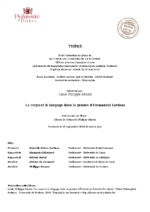Benoit Louis Philippe
Le corps et le langage dans la pensée d'Emmanuel Levinas
frDépôt légal électroniqueConsulter le texte intégral de la thèse (format PDF)

Résumé
Français
Le corps et le langage dans la pensée d'Emmanuel Levinas
Alors de manière plus classique, depuis Aristote, l'homme est défini comme un animal doué de langage, la pensée de Levinas nous amène à penser un nouvel humanisme, dans les structures d'altérité, de passivité, d'ouverture, de proximité, d'exposition et de responsabilité. D'emblée, l'homme, en tant que être de langage, est aussi être "de chair et de sang". Ainsi, il est connu comme être de chair et de langage. Pour penser la subjectivité, il faut la penser comme un territoire, fait de deux domaines : de corps et de langage. C'est à partir du corps que l'on peut découvrir la concrétude de l'homme. C'est à partir du langage qu'on peut lui lancer une adresse, une convocation et aussi répondre à cette adresse. Le nouvel humanisme, l'humanisme de l'autre homme, ainsi est de corps et de langage, comme "ses deux mains de l'humble créature", est assigné à la responsabilité de soi et pour autrui. L'expérience du corps et du langage est les deux piliers qui permettent de penser la relation interhumaine, nécessaire pour une expérience de la transcendance et de sa signifiance. La relecture des notions de thématisation, de représentation, de conscience, d'intentionnalité, de compréhension de l'être, nous a permis de voir comment Levinas envisage de donner à la philosophie un autre souffle et une autre direction. En libérant le langage philosophique de ce qu'il appelle le système ou l'impérialisme de la conscience ou de l'être, Levinas ouvre la voie à la transcendance de l'autre et de l'absolument Autre, à Dieu et au-dehors. La tâche de la pensée, c'est de déterminer à travers le corps et le langage, la signifiance de la subjectivité, d'autrui, de Dieu, de la transcendance et de l'infini. Il s'agit de déterminer aussi "comment ils viennent au langage, y provoquent la pensée, y font sens".
Mots-clés libres : Thématisation, représentation, conscience, intentionnalité, compréhension de l'être, Levinas, corps et langage, transcendance.
- Levinas, Emmanuel (1906-1995) -- Critique et interprétation
- Image du corps
- Individualité
- Connaissance de soi
English
The body and language in the thought of Emmanuel Levinas
Since Aristotle's time, Man is classically defined as an animal capable of using spoken language. Levinas' opinions and thoughts introduce us to a new form of humanism, one structured by otherness, passivity, openness, proximity, exposure, and responsibility. As a being of language, Man is fundamentally too a being "of flesh and blood". He is then as such known as a being of flesh and language. Subjectively, we may think of it as a territory divided into two parts of area: body and language. It is from his body, that man's concreteness can be discovered. It is via language that we can address him and summon him and it is via this same language that he can respond to the call. The new humanism, other Man's humanism, brings into play thus both body and language, as "the two hands of this humble creature" bear both its own and others' responsability. The experience of body and language are the two pillars that enable us to think about the subjectivity, without wich meaningful and transcendental experience cannot be attained. The replay of notions of theming representation, consciousness, intentionality, comprehension of being, allowed us to see how Levinas breathes new life into philosophy and gives it a new direction. Releasing the philosophical language from what he calls the system, from the imperialism of consciousness, or from human beings, Levinas opens a way to the transcendence of the other and the absolutely Other, to God and to the exterior. To think is to determine through the body and language the meaningfulness of subjectivity, of others, of God, transcendence, and infinity. It is also about determining "how they discover language, throughts, and give meaning".
Keywords : Thematisation, representation, consciousness, intentionality, understanding of being, Levinas, body and language, transcendence.
Notice
- Diplôme :
- Doctorat d'Université
- Établissement de soutenance :
- Université de Poitiers
- UFR, institut ou école :
- UFR de sciences humaines et arts (SHA)
- Laboratoire :
- Laboratoire Métaphysiques allemandes et philosophie pratique (Poitiers)
- Domaine de recherche :
- Philosophie
- Directeur(s) de thèse :
- Jérôme de Gramont, Philippe Grosos
- Date de soutenance :
- 13 septembre 2016
- Président du jury :
- Danielle Cohen-Levinas
- Rapporteurs :
- Emmanuel Housset, Edvard Kovač
- Membres du jury :
- Jérôme de Gramont, Philippe Grosos
Menu :
-
-
À propos d'UPthèses
-
Voir aussi
Annexe :
-
Une question ?
Avec le service Ubib.fr, posez votre question par chat à un bibliothécaire dans la fenêtre ci-dessous :
ou par messagerie électronique 7j/7 - 24h/24h, une réponse vous sera adressée sous 48h.
Accédez au formulaire...
Université de Poitiers - 15, rue de l'Hôtel Dieu - 86034 POITIERS Cedex - France - Tél : (33) (0)5 49 45 30 00 - Fax : (33) (0)5 49 45 30 50
these@support.univ-poitiers.fr -
Crédits et mentions légales
